History
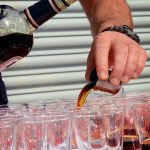 There are some traditions or practices that, upon further consideration, are not necessarily good traditions or practices. Between 1850 and as recently as 1970, sailors on Royal Navy Ships were given a daily rum ration, which was also called a tot, at midday every day. The amount of alcohol it contained was about 1/8 of a pint of rum at 95.5 proof. The practice was discontinued in 1970 because it was thought that regular intakes of alcohol would lead to unsteady hands when working machinery. Senior ratings of petty officer and above received their rum neat, while it was diluted with two parts of water, known a grog, to make 3/8 of an imperial pint for junior ranks. The rum ration was served from one particular barrel, which was ornately decorated and was made of oak and reinforced with brass bands with brass letters saying “The Queen, God Bless Her.” It was known as the “Rum Tub.”
There are some traditions or practices that, upon further consideration, are not necessarily good traditions or practices. Between 1850 and as recently as 1970, sailors on Royal Navy Ships were given a daily rum ration, which was also called a tot, at midday every day. The amount of alcohol it contained was about 1/8 of a pint of rum at 95.5 proof. The practice was discontinued in 1970 because it was thought that regular intakes of alcohol would lead to unsteady hands when working machinery. Senior ratings of petty officer and above received their rum neat, while it was diluted with two parts of water, known a grog, to make 3/8 of an imperial pint for junior ranks. The rum ration was served from one particular barrel, which was ornately decorated and was made of oak and reinforced with brass bands with brass letters saying “The Queen, God Bless Her.” It was known as the “Rum Tub.”
As is normal, there were some sailors who did not drink. So the question became, how would they be compensated. It was decided that these sailors would have a mark by their name of “T” for the Temperance movement. Sailors who opted to be “T” were given three pence, or about $1.00 a day instead of the rum ration. It is said that most of the men preferred the rum. The time when the rum ration was distributed was called “Up Spirits,” which was between 11 am and 12 noon. A common cry from the sailors was “Stand fast the Holy Ghost.” This was in response to the bosun’s call “Up Spirits.” Each mess had a “Rum Bosun” who would collect the rum from the officer responsible for measuring the right number of tots for each mess. The officers did not get a rum ration. Another strange tradition associated with rum rations is that the Tot glasses were kept separate from any other glasses. This was because they were washed on the outside, but never inside, in the belief that residue of past tots would stick to the side of the glass and make the tot even stronger. I would consider that to be really gross, but I’m not a sailor. Sailors under 20 were not permitted a rum ration, and were marked on the ship’s books as “UA” (Under Age).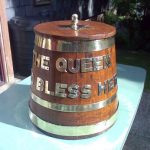
A sailor’s ration of alcohol was originally beer. At that time, a daily ration of one gallon was given. This official allowance continued until after the Napoleonic Wars. When beer was not available, as often happened due to spoilage, it could be substituted by a pint of wine or half a pint of spirits depending on what was locally available. Later, the political influence of the West Indian planters led to rum being given the preference other spirits. The half pint of spirits was originally issued neat, or without water. It is said that sailors would “prove” its strength by checking that gunpowder doused with rum would still burn (thus verifying that rum was at least 57% ABV). I guess they didn’t trust the bar tender. “The practice of compulsorily diluting rum in the proportion of half a pint to one quart of water (1:4) was first introduced in the 1740s by Admiral Edward Vernon (known as Old Grog, because of his habitual grogram cloak). The ration was also split into two servings, one between 10 am and noon and the other between 4 and 6 pm. In 1756 Navy regulations required adding small quantities of lemon or lime juice to the ration, to prevent scurvy. The rum itself was often procured from distillers in Jamaica, Trinidad and Tobago and the British Virgin Islands. Rations were cut in half in 1823 and again in half, to the traditional amount, in 1850.”
In 1850, Parliament discussed the abolition of the rum ration, then again in 1881, but nothing came of it. In 1970, Admiral Peter Hill-Norton abolished the rum ration as he felt it could have led to sailors failing a breathalyzer test and being less capable to manage complex machinery. This decision to end the rum ration was taken after the Secretary of State for Defense had taken opinions from several ranks of the Navy. Ratings were instead allowed to purchase beer, and the amount allowed was determined, according to the MP David Owen, by the amount of space available for stowing the extra beer in ships. The last rum ration was on July 31, 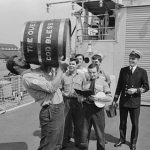 1970 and became known as Black Tot Day, because sailors were unhappy about the loss of the rum ration. There were reports that sailors threw tots into the sea and the staging of a mock funeral in a training camp. In place of the rum ration, sailors were allowed to buy three one-half imperial pint cans of beer a day and improved recreational facilities. While the rum ration was abolished, the order to “splice the mainbrace,” or awarding sailors an extra tot of rum for good service, remained as a command which could only be given by the Monarch and is still used to recognize good service. Rum rations are also given on special occasions. Examples include the 100th anniversary of the Canadian Royal Navy in 2010 and after the Queen’s Diamond Jubilee celebrations in 2012.
1970 and became known as Black Tot Day, because sailors were unhappy about the loss of the rum ration. There were reports that sailors threw tots into the sea and the staging of a mock funeral in a training camp. In place of the rum ration, sailors were allowed to buy three one-half imperial pint cans of beer a day and improved recreational facilities. While the rum ration was abolished, the order to “splice the mainbrace,” or awarding sailors an extra tot of rum for good service, remained as a command which could only be given by the Monarch and is still used to recognize good service. Rum rations are also given on special occasions. Examples include the 100th anniversary of the Canadian Royal Navy in 2010 and after the Queen’s Diamond Jubilee celebrations in 2012.
 Sometimes, no matter how hard the airlines work to prevent it, things go wrong. Alaskan Airlines flight 1866, which became the first fatal jet airliner crash involving Alaska Airlines, was on a routine flight from Anchorage, Alaska to Seattle, Washington. The flight was scheduled to make intermediate stops at Cordova (CDV) and Yakutat (YAK/PAYA), which it made. It was also scheduled to stop in Juneau and Sitka before ending in Seattle. Things were going along smoothly when the flight landed at Yakutat at 11:07am and then departed at 11:35am for Juneau. The flight was operated by IFR (Instrument Flight Rules). At 09:13 Flight AS1866 departed from Anchorage and landed at 09:42 in Cordova. Something was not right with the luggage upon departing Cordova, so the flight landed at Yakutat at 11:07am. Problem solved the plane took off again at 11:35am headed for Juneau.
Sometimes, no matter how hard the airlines work to prevent it, things go wrong. Alaskan Airlines flight 1866, which became the first fatal jet airliner crash involving Alaska Airlines, was on a routine flight from Anchorage, Alaska to Seattle, Washington. The flight was scheduled to make intermediate stops at Cordova (CDV) and Yakutat (YAK/PAYA), which it made. It was also scheduled to stop in Juneau and Sitka before ending in Seattle. Things were going along smoothly when the flight landed at Yakutat at 11:07am and then departed at 11:35am for Juneau. The flight was operated by IFR (Instrument Flight Rules). At 09:13 Flight AS1866 departed from Anchorage and landed at 09:42 in Cordova. Something was not right with the luggage upon departing Cordova, so the flight landed at Yakutat at 11:07am. Problem solved the plane took off again at 11:35am headed for Juneau.
What happened next, sealed the fate of all 111 people onboard the flight. The date was September 4, 1971, and it was rainy day, with low clouds. Somehow, not everyone saw the situation in the same way, but the closest accounts to reality were the ones that had the plane flying into low clouds. According to the witnesses, it then flew straight into the Chilkat Mountains in Haines Borough, near Juneau, Alaska.
The aircraft was a Boeing 727-100 with U.S. registry N2969G. It was scheduled to stop in Juneau and Sitka before ending in Seattle. The aircraft was manufactured in 1966 as c/n 19304 and manufacturer’s serial number 287. It had accumulated 11,344 flight hours prior to the incident. Seven crew members were aboard, as well as 104 passengers. The plane was told to descend and maintain 12,000 feet, and the tower asked for confirmation that the level had been maintained during a maneuver to line up for landing. He was told that the flight level had been maintained, but in reality, it couldn’t have been. At 12:00, the dispatcher repeated the permit for passing the Howard point, and also estimated the approach time as 12:10. At 12:01 Flight 1866 reported passing 12 thousand feet. At 12:07, the plane was asked about its location relative to the landing course and the waiting pattern, and the controller reported that Flight 1866 had just entered the approach scheme and followed the Howard radio beacon, after which it gave permission to descend to pass the directional beacon at a height of no more than 9 thousand feet. The crew confirmed the permission to descend and reported on leaving a height of 12 thousand feet. At 12:08, the controller asked about the altitude, with the flight responding, “…leaving five thousand five… four thousand five hundred.” Flight 1866 was then instructed to contact the Juneau ATC Tower. The crew acknowledged the transmission and then changed to the tower frequency. The tower controller said, “Alaska 66, understand, ah, I didn’t, ah, copy the intergusts to 28, the altimeter now 29.47, time is 09 112. call section, landing Runway 8, the wind 0800 at 22 occasional us by Barlow”. The crew of Flight 1866 did not respond.
“According to the testimonies of three eyewitnesses, at this time there was a little rain, and the sky was covered with clouds. According to the meteorological service of the airport, at 11:56, the sky was partly cloudy with a lower boundary of 1,500 feet and up to 3,500 feet, and up to 7,500 feet – full clouds, light rain, visibility 15 miles. Also at 1:10 pm a pilot flying from Juneau to Sitka reported weather at 11:15 – overcast, light rain, lower cloud limit 1000 feet, upper – 3000 feet, visibility 10 miles, mountain tops and passes closed. Two witnesses who were in the region of the Chilkat Mountains stated that they heard a low-flying aircraft, but  could not see it because of low visibility, which they estimated at 55-65 meters. The sound of the engines was normal. Then after a minute there was an explosion. The third witness saw a plane that disappeared into the clouds, but then did not hear any sounds. At 12:15, aircraft struck the eastern slope of a canyon in the Chilkat Range of the Tongass National Forest at the 2500-foot level, 22 miles west of Juneau. The aircraft exploded on impact.” When the crew stopped responding, at 12:23, an immediate search for Flight 1866 began. A few hours later, the wreckage of the aircraft was found on the eastern slope of the Chilkat ridge at 21.3 miles west of Juneau airport. There were no survivors.
could not see it because of low visibility, which they estimated at 55-65 meters. The sound of the engines was normal. Then after a minute there was an explosion. The third witness saw a plane that disappeared into the clouds, but then did not hear any sounds. At 12:15, aircraft struck the eastern slope of a canyon in the Chilkat Range of the Tongass National Forest at the 2500-foot level, 22 miles west of Juneau. The aircraft exploded on impact.” When the crew stopped responding, at 12:23, an immediate search for Flight 1866 began. A few hours later, the wreckage of the aircraft was found on the eastern slope of the Chilkat ridge at 21.3 miles west of Juneau airport. There were no survivors.
 I recently read a book about the orphan trains, which ran between 1854 and 1929. During that time, approximately 250,000 orphaned, abandoned, and homeless children ride the train throughout the United States and Canada, to be placed with families who were looking for a child, or just as often, a worker for their farm. The orphan train movement was necessary, because at the time, it was estimated that 30,000 abandoned children were living in the streets in New York City. I had heard of the orphan trains, mostly from the movie called “Orphan Train,” but much of what really happened with those children was very new to me, and quite shocking.
I recently read a book about the orphan trains, which ran between 1854 and 1929. During that time, approximately 250,000 orphaned, abandoned, and homeless children ride the train throughout the United States and Canada, to be placed with families who were looking for a child, or just as often, a worker for their farm. The orphan train movement was necessary, because at the time, it was estimated that 30,000 abandoned children were living in the streets in New York City. I had heard of the orphan trains, mostly from the movie called “Orphan Train,” but much of what really happened with those children was very new to me, and quite shocking.
Today, while my husband, Bob Schulenberg and I were in the Black Hills, we rode the 1880 Train, as we almost always do when we are here. When they mentioned that the train had been 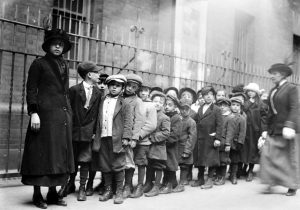 used in the movie “Orphan Train,” a fact that I had heard many times before, the stories from the book I had read came back to mind. My mind instantly meshed to train, the book, and the movie into one event.
used in the movie “Orphan Train,” a fact that I had heard many times before, the stories from the book I had read came back to mind. My mind instantly meshed to train, the book, and the movie into one event.
The children who traveled on the orphan trains were victims of circumstance, and they had no control over their lives at all. Each one hoped that their new family would be nice. The older ones didn’t have high hopes. The older boys pretty much knew that they would be farm hands. And most of them were right many were made to sleep in the barn, because they were thought to be thieves. If they were thieves, it was because they had to steal to survive. They did whatever it took to survive.
 As Bob and I rode the train today, in the eye of my imagination, I could picture what it must have been like to be one of those orphans. The were sitting there watching that big steam engine take them to someplace they didn’t know, and probably didn’t want to go. They didn’t have high hopes for a great future, but then again, the past wasn’t that great either. They were forced to make the best of a bad situation, and the people who were in charge didn’t really care what happened to them. They were just doing their jobs. I have ridden the 1880 Train many times before, but today, it felt a little bit different, somehow. I knew that I wasn’t an orphan riding that train, but I certainly felt empathy for the children who were.
As Bob and I rode the train today, in the eye of my imagination, I could picture what it must have been like to be one of those orphans. The were sitting there watching that big steam engine take them to someplace they didn’t know, and probably didn’t want to go. They didn’t have high hopes for a great future, but then again, the past wasn’t that great either. They were forced to make the best of a bad situation, and the people who were in charge didn’t really care what happened to them. They were just doing their jobs. I have ridden the 1880 Train many times before, but today, it felt a little bit different, somehow. I knew that I wasn’t an orphan riding that train, but I certainly felt empathy for the children who were.
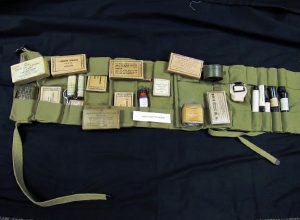 During World War II, if a man was a conscientious objector, things were…difficult. Things like that were not an automatic get out of the war card. Unless they had some necessary skill that would keep them stateside or in an office, they were signed up as a medic. Most of those men thought that was a good place for them, since the would be saving lives and not taking them, but I’m not sure who got it worse. The infantry or the medics.
During World War II, if a man was a conscientious objector, things were…difficult. Things like that were not an automatic get out of the war card. Unless they had some necessary skill that would keep them stateside or in an office, they were signed up as a medic. Most of those men thought that was a good place for them, since the would be saving lives and not taking them, but I’m not sure who got it worse. The infantry or the medics.
The men of the infantry usually considered the conscientious objectors to be cowards. That is not really the way a guy wanted to go into the army, but if they were seriously conscientious objectors, it was a calling they took seriously. 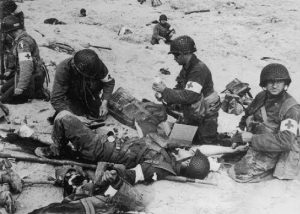 It was not, however, an easy job or the easy way out of combat. The difference between the infantrymen and the medics was that during combat, the infantrymen did their best to stay down, so the weren’t hit. The medics, on the other hand, ran into the fire to treat the wounded, and bring in the dead. It was no easy job.
It was not, however, an easy job or the easy way out of combat. The difference between the infantrymen and the medics was that during combat, the infantrymen did their best to stay down, so the weren’t hit. The medics, on the other hand, ran into the fire to treat the wounded, and bring in the dead. It was no easy job.
The medics, like most soldiers coming into the army were young men…boys really. They were often 18 or 19 years old. The infantrymen had plenty of names for them. None of them were nice…or complimentary, but the medics that stayed medics…the ones who ran into the fire to care for a wounded soldier were given new names. They were finally called medic…or more often Doc. And they were respected. They were also called hero, brave, courageous, and other respectful names. The 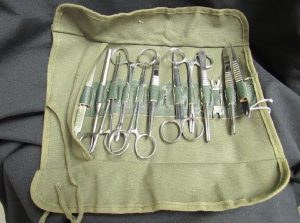 medics were not given the $10.00 per month extra that combat soldiers were given. That made the infantrymen furious. They collected money from each other to provide combat pay for their medics. The men refused to have their medics receive less.
medics were not given the $10.00 per month extra that combat soldiers were given. That made the infantrymen furious. They collected money from each other to provide combat pay for their medics. The men refused to have their medics receive less.
World War II saw eleven medics who received the Medal of Honor…as well as other medals. These men were wounded taking care of the men, and they were even killed saving the lives of the men in their care. These men were heroes, just like their counterparts in the infantry, and there isn’t an infantryman that ever fought, who would disagree.
 Whether it was World War I or World War II, every flyer knew what a dogfight was. Dogfights were the undisputed, most intense type of aerial combat there was. Basically it was an intense game of chicken…one that no one really wanted to play. The fight for supremacy in the skies over Europe was vital to the war effort. The Axis of Evil nations had to be stopped, and the air war was going to be the way to win the war.
Whether it was World War I or World War II, every flyer knew what a dogfight was. Dogfights were the undisputed, most intense type of aerial combat there was. Basically it was an intense game of chicken…one that no one really wanted to play. The fight for supremacy in the skies over Europe was vital to the war effort. The Axis of Evil nations had to be stopped, and the air war was going to be the way to win the war.

After watching some of the cockpit footage of the dogfights, I don’t know how those pilots did it. In the non-war world, two planes going head to head is not an ideal situation, but that was what the fighter planes of war have to do. As one plane starts to gain dominance over another, the plane being chased often goes into a steep climb, followed by the pursuing plane. The first plane to stall is going to end up being chased, because as he loses power, he drops and then must run first to gain power and then to get away from his attacker. If you thought going head to head with another plane was scary, imagine a deliberate stall…for supremacy!! That just seems insane to me, but that is 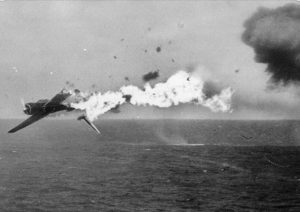 the nature of the dogfight. These pilots had to be very brave. There is no way to fly like that, or especially fight like that unless you area very brave pilot…not to mention a skilled pilot. Without that skill, the pilots would not survive long enough to even become an ace.
the nature of the dogfight. These pilots had to be very brave. There is no way to fly like that, or especially fight like that unless you area very brave pilot…not to mention a skilled pilot. Without that skill, the pilots would not survive long enough to even become an ace.
For a fighter pilot to become an ace, he had to shoot down five enemy planes. A gunner could become an ace too, but the majority of aces are fighter pilots. The key to becoming an ace, besides shooting down the enemy, is obviously to stay alive long enough to become an ace. In these dogfights, that was difficult for sure.
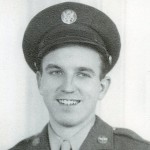
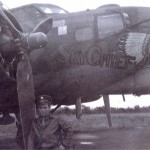 After World War II, many of the veterans were hesitant to talk about their experiences. My dad, Allen Spencer was one of those men. We were never exactly sure why he didn’t talk about it, but thought that he didn’t want to brag. I don’t really think that was it at all.
After World War II, many of the veterans were hesitant to talk about their experiences. My dad, Allen Spencer was one of those men. We were never exactly sure why he didn’t talk about it, but thought that he didn’t want to brag. I don’t really think that was it at all.
While listening to an audiobook called Citizen Soldiers, which covers the D-Day battle and the Battle of the Bulge, it hit me…even before the author said it. The reason soldiers didn’t talk much about war was a deliberate effort to forget. Unfortunately for most of her them, forgetting was impossible. Their minds were filled with haunted memories. The book mostly covers the thoughts of the infantry, but touches on the air war too.
After listening to the author’s account of the battle, I don’t think I could ever forget either, and I wasn’t there. Memories of the 19 year old farm boy away from home for the first time, and not really trained for combat. When the shooting started, he stood up to fire. Other soldiers told him to get down, by it was too late. His first battle had become his last, as an enemy bullet pierced his forehead. The soldiers who witnessed it, felt sick to 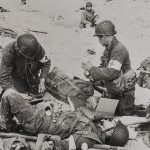
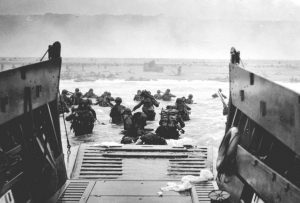 their stomachs. It was a time when a seasoned veteran was just 22 years old…and he had been made an office when his commanding officer was killed. There weren’t very many of the older men left…and by older I mean 30.
their stomachs. It was a time when a seasoned veteran was just 22 years old…and he had been made an office when his commanding officer was killed. There weren’t very many of the older men left…and by older I mean 30.
There were memories of a young prisoner of war, packed into a train to the POW camps was singing in his beautiful tenor voice, all the Christmas music he could think of to help raise moral. It was working, but suddenly the trains were under attack. The prisoners couldn’t get out, and the guards had run away. Finally a skinny boy was able to get out through a tiny window. He opened the door to his car and the men moved to free the other prisoners. There was really nowhere to go, but they escaped the attack. Then, the guards came back and loaded them back on the train. When someone asked the tenor to sing some more, they were told that he hadn’t made it back. His sweet voice was forever silenced. The men on the train were silent too…sick at heart.
The fighters in the plane’s overhead knew that it was kill or be killed, but whenever a plane went down, enemy 
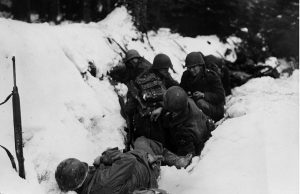 or one of theirs, they counted the parachutes, hoping the men got out alive. For them non the planes dropping bombs, they knew that someone below went to work that day, having no idea tat they would not be returning home again. They had been simple factory workers, just doing what they were told. And what of the missed targets that landed bombs on schools and other civilian locations. The men in the planes above had to live with that. They had done their duty, but it certainly didn’t feel good.
or one of theirs, they counted the parachutes, hoping the men got out alive. For them non the planes dropping bombs, they knew that someone below went to work that day, having no idea tat they would not be returning home again. They had been simple factory workers, just doing what they were told. And what of the missed targets that landed bombs on schools and other civilian locations. The men in the planes above had to live with that. They had done their duty, but it certainly didn’t feel good.
 I have long been interested in war, and especially World War II. Every aspect of it interests me, and I find myself wondering about the enemy. I’m sure that might seem odd to many people, but as we have found in the United States, just because the government goes to war, does not mean that every citizen, or even every soldier agrees with the reasons the country has gone to war. I have been listening to a couple of audiobooks that have taken in D-Day, and I came across something interesting.
I have long been interested in war, and especially World War II. Every aspect of it interests me, and I find myself wondering about the enemy. I’m sure that might seem odd to many people, but as we have found in the United States, just because the government goes to war, does not mean that every citizen, or even every soldier agrees with the reasons the country has gone to war. I have been listening to a couple of audiobooks that have taken in D-Day, and I came across something interesting.
Without going into all of that amazing strategy of warfare, I want to focus on one of the bombing maneuvers that took place. One of the soldiers on the ground was trying to take cover from incoming German bombs. After the bombing stopped, he looked out and was shocked to see eight bombs embedded in the ground near his foxhole. They had not gone off. He knew that it is possible for bombs to be duds, but he hadn’t heard of any American bombs that had turned out to be duds…especially eight of them at the same time, in the same place.  He wasn’t bragging on the American bombs, their craftmanship, or their ingenuity, but rather, wondering how so many German bombs could have been duds…all at the same time.
He wasn’t bragging on the American bombs, their craftmanship, or their ingenuity, but rather, wondering how so many German bombs could have been duds…all at the same time.
Then the soldier made an observation that I had not considered, but that fell right into my view that not everyone in Germany agreed with Hitler. The American bomb builders were doing their job willingly. They were working to make the bombs efficient, because Germany needed to be defeated. In contrast, the German bomb builders were actually Polish slaves. Hitler had invaded their nation and was forcing them to play a part in a war that they disagreed with. The soldier considered these things and came to the conclusion that somehow the Polish slaves had been able to build a bomb that they knew would not explode, but would still pass the inspections of the Germans. The soldier believed that eight unexploded bombs could not be coincidental. It had to be sabotage.
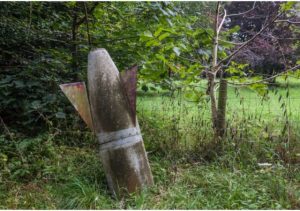
In my research, I have seen situations where the citizens have helped the enemy, at great risk to their own safety. I have seen situations where the citizens have given aid to the enemy. And this situation was a blatant sabotage of the weapons of warfare. Within their nations, these acts were acts of treason, but they were actually fighting the evil that had tried to take over their nation. Within their confines, they were standing up for their values…for good, and for what was right. They were the enemy, in location only, because in their hearts, the were fighting for what was right, and I have to respect them for that.
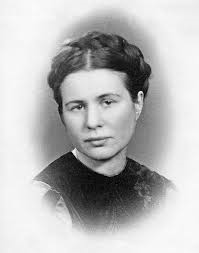 Some would consider the actions of Irena Sendler a crime, while others would consider them heroic. I suppose it was a crime, at the time it happened…a crime of opportunity, because her actions were illegal, but how could she had done anything different? Irena Sendler was born in Otwock, Poland, on February 15, 1910, to Stanislaw Henryk Krzyzanowski, a physician, and his wife, Janina Karolina Grzybowska Krzyzanowski. Irena grew up there in Otwock, a town about 15 miles southeast of Warsaw, where there was a Jewish community. Her father was a kind man who treated the very poor, including Jews, free of charge. Stanislaw died in February 1917 after he contracted typhus from his patients. After his death, the Jewish community offered financial help for the widow and her daughter, though Janina Krzyzanowski declined their assistance. I’m sure she knew they really didn’t have the money to help, but offered because of her husband.
Some would consider the actions of Irena Sendler a crime, while others would consider them heroic. I suppose it was a crime, at the time it happened…a crime of opportunity, because her actions were illegal, but how could she had done anything different? Irena Sendler was born in Otwock, Poland, on February 15, 1910, to Stanislaw Henryk Krzyzanowski, a physician, and his wife, Janina Karolina Grzybowska Krzyzanowski. Irena grew up there in Otwock, a town about 15 miles southeast of Warsaw, where there was a Jewish community. Her father was a kind man who treated the very poor, including Jews, free of charge. Stanislaw died in February 1917 after he contracted typhus from his patients. After his death, the Jewish community offered financial help for the widow and her daughter, though Janina Krzyzanowski declined their assistance. I’m sure she knew they really didn’t have the money to help, but offered because of her husband.
In 1931, Irena married Mieczyslaw Sendler, and the couple moved to Warsaw before the outbreak of World War II. The couple divorced in 1947. Irena then married Stefan Zgrzembski. They had three children, Janina, Andrzej (who died in infancy), and Adam (who died of heart failure in 1999). Then, they divorced in 1957. She remarried Mieczyslaw Sendler in 1961, but they divorced again in 1971. In college, Irena 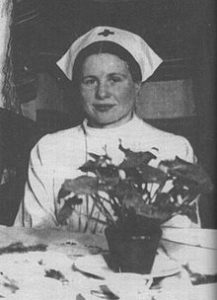 had studied to became a social worker, and she remembered the lessons of her father…to show kindness to others. It was a life lesson that would prove useful in Irena’s future.
had studied to became a social worker, and she remembered the lessons of her father…to show kindness to others. It was a life lesson that would prove useful in Irena’s future.
When the Nazis invaded Poland in 1939, Irena had access to the Warsaw Ghetto through her job. The ghetto was where hundreds of thousands of Jews were imprisoned. The situation there appalled her. Irena became a member of the Council to Aid Jews, and worked as a social worker, overseeing the city’s canteens, which provided assistance to people in need. After the Nazi invasion, Irena and her colleagues also used the canteens to provide medicine, clothing and other necessities to the city’s persecuted Jewish population. Her actions enabled her to help rescue 2,500 Jewish children from the ghetto. The group had several ways of smuggling the children out of the ghetto. Some were carried out in caskets or potato sacks, while others left in ambulances or snuck out through underground tunnels. Still others entered the Jewish side of a Catholic church that straddled the ghetto boundary and left on the other side with new identities. Irena then helped place the children at convents or with non-Jewish families. The operation was run with clockwork-like precision. As the situation grew worse for the ghetto’s inhabitants, Irena went beyond rescuing orphans and began asking parents to let her try to get their children to safety. Although she couldn’t guarantee the children’s survival, she could tell parents that their children would at least have a chance. The parents knew that it would be their  children’s only chance. Irena kept detailed records and lists of the children she helped buried in a jar. She planned to reunite the rescued children and their parents after the war. Unfortunately, most of the parents did not survive.
children’s only chance. Irena kept detailed records and lists of the children she helped buried in a jar. She planned to reunite the rescued children and their parents after the war. Unfortunately, most of the parents did not survive.
On October 20, 1943, the Nazis arrested Irena and sent her to Pawiak Prison. She was tortured in an attempt to get her to reveal the names of her associates. She refused and was sentenced to death. However, Council to Aid Jews members bribed the prison guards, and Irena was released in February 1944. Irena continued her work until the war ended, by which time she and her colleagues had rescued approximately 2,500 children. It has been estimated that Irena personally saved about 400 children. In 1965, Irena was honored for her courageous actions during the Holocaust. She was given Israel’s Yad Vashem to honor her as “Righteous Among the Nations.” Irena died in Warsaw, Poland on May 12, 2008, at the age of 98.
 On August 23, 1885, the schooner, Sweepstakes hit a rock near Cove Island on the Canadian side of Lake Huron, and sank in shallow water close to the light station. There she remained until transport could be arranged. Sweepstakes was built in Burlington, Ontario in 1867, by Melancthon Simpson. The wooden schooner’s had two masts, and sported a length 119 feet. The hull’s maximum depth was 20 feet. The schooner weighed approximately 218 tons. Sweepstakes was last owned by George Stewart, who lived in Mooretown, Ontario. Because she ran aground on a rock, her crew were able to escape, so her sinking took with it only one casualty…Sweepstakes, herself. She rests in the Fathom Five National Marine Park.
On August 23, 1885, the schooner, Sweepstakes hit a rock near Cove Island on the Canadian side of Lake Huron, and sank in shallow water close to the light station. There she remained until transport could be arranged. Sweepstakes was built in Burlington, Ontario in 1867, by Melancthon Simpson. The wooden schooner’s had two masts, and sported a length 119 feet. The hull’s maximum depth was 20 feet. The schooner weighed approximately 218 tons. Sweepstakes was last owned by George Stewart, who lived in Mooretown, Ontario. Because she ran aground on a rock, her crew were able to escape, so her sinking took with it only one casualty…Sweepstakes, herself. She rests in the Fathom Five National Marine Park.
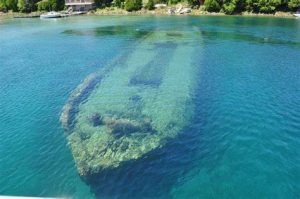
On September 3rd the tug Jessie towed Sweepstakes into Big Tub Harbor so she could be repaired, but it was found that the Sweepstakes was beyond repair. So, the repair soon became a salvage of sorts. She was stripped of all useful rigging and equipment. The she sank in her present location in Tub Harbor, at Tobermory, Ontario, Canada. At the time of her sinking, Sweepstakes was still fully loaded with coal. Her cargo was salvaged at a later date. It seems a sad end to the little ship that was majestic in her time, but it isn’t really the end for her.
The area where Sweepstakes now lies is a fairly shallow spot, so she is visible to people on small boats passing 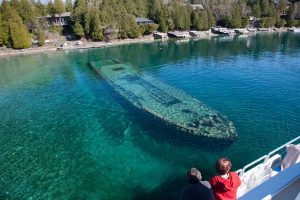 nearby. Her hull is almost completely intact, and she rests in about 20 feet of very clear water at the head of Big Tub Harbor. Two mooring buoys mark her location as a warning to unsuspecting boaters. Although deteriorating a little more each year, the Sweepstakes is one of the best preserved nineteenth-century Great Lakes schooners to be found. Nearby, the wreck of The City Of Grand Rapids rests. Both wrecks are visited frequently by glass-bottom tour boats. During the spring and fall, the site is shared by both divers and boats. Even just looking at pictures of the boats is interesting. It’s almost strange to think you can see a shipwreck from the top of the water.
nearby. Her hull is almost completely intact, and she rests in about 20 feet of very clear water at the head of Big Tub Harbor. Two mooring buoys mark her location as a warning to unsuspecting boaters. Although deteriorating a little more each year, the Sweepstakes is one of the best preserved nineteenth-century Great Lakes schooners to be found. Nearby, the wreck of The City Of Grand Rapids rests. Both wrecks are visited frequently by glass-bottom tour boats. During the spring and fall, the site is shared by both divers and boats. Even just looking at pictures of the boats is interesting. It’s almost strange to think you can see a shipwreck from the top of the water.
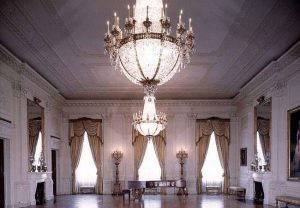 With the new school year just beginning, the reality is that the year’s end will arrive in incredibly short order. Football, basketball, and track will be over, and before we know it, the high school students are getting ready for prom again. Everyone wants their prom to be that wonderful dance that is unforgettable…one that they can carry the memories of forever. Proms are usually held in the school gym, or maybe at an events center, and on rare occasions, a hotel, but in 1975, in Washington DC, was held what could only be called the ultimate prom!! And don’t think your school could duplicate this particular prom, because they couldn’t. This particular prom was held at the White House!! It was the only prom ever to be held at the executive mansion, which makes it an odd event in White House social history.
With the new school year just beginning, the reality is that the year’s end will arrive in incredibly short order. Football, basketball, and track will be over, and before we know it, the high school students are getting ready for prom again. Everyone wants their prom to be that wonderful dance that is unforgettable…one that they can carry the memories of forever. Proms are usually held in the school gym, or maybe at an events center, and on rare occasions, a hotel, but in 1975, in Washington DC, was held what could only be called the ultimate prom!! And don’t think your school could duplicate this particular prom, because they couldn’t. This particular prom was held at the White House!! It was the only prom ever to be held at the executive mansion, which makes it an odd event in White House social history.
Our president at the time was Gerald Ford, and he had a 17 year old daughter named Susan. Like most daughters, Susan knew that her daddy wanted to make her happy. So, she asked him if her high school could hold their prom at the White House. It was the first and only prom ever to be held there…and not something that is likely to happen again. Susan went to school at the Holton-Arms school. The prom was held on March 31, 1975, and President and Mrs Ford were on their way from Belgium to Spain as part of a diplomatic tour of Europe. In their place was the president’s sister-in-law, Janet Ford, “a small figure in a white lace dress, casting  a tolerant but observant eye on the proceedings.”
a tolerant but observant eye on the proceedings.”
Over forty years later, the students who attended the regal prom still carry those wonderful memories of a very special prom that could never be equaled. They even got to take a sunset cruise on the presidential yacht. Many parties have been held at the White House, but none quite like this one. The White House was rockin’ that Saturday, with Susan Ford. her classmates and their dates, dancing the bump and the hustle in the East Room until 1:00am. Susan had been a student at the Holton-Arms School, an academy for girls in Bethesda, Maryland, since her freshman year. “The members of the class of 1975 paid the cost of the prom…$1,300, after raising funds at bake sales and school fairs. Tablecloths were made out of floral pink and yellow sheets. The menu included Swedish meatballs and quiche, as well as a nonalcoholic punch made of tea, lemonade, soda, grape juice, and sugar. Susan and her classmates assembled the centerpieces, candles in a setting of daisies, tulips, lilies, sweet peas, and ming fern.”
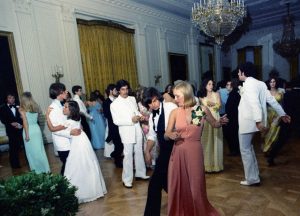 “The girls wore long dresses, light makeup, casual hairdos, and, in many cases, orchid corsages,” the Associated Press reported. “Many of their escorts, in black or white tuxedos, wore boutonnieres and below-the-collar length hair.” “Susan, at that age, was strikingly beautiful,” says Sally Alexander, a retired English teacher at Holton-Arms, who was one of six chaperones. “And it’s a great deal of fun to watch a bunch of beautiful young girls with handsome young men, all dressed up. They were clearly excited about being where they were, but they were not uncomfortably awed. It was a beautiful affair.” And of course, the media was there to document the entire historic prom. So, if you want your prom to be this cool, you had better start planning now…or maybe several years ago.
“The girls wore long dresses, light makeup, casual hairdos, and, in many cases, orchid corsages,” the Associated Press reported. “Many of their escorts, in black or white tuxedos, wore boutonnieres and below-the-collar length hair.” “Susan, at that age, was strikingly beautiful,” says Sally Alexander, a retired English teacher at Holton-Arms, who was one of six chaperones. “And it’s a great deal of fun to watch a bunch of beautiful young girls with handsome young men, all dressed up. They were clearly excited about being where they were, but they were not uncomfortably awed. It was a beautiful affair.” And of course, the media was there to document the entire historic prom. So, if you want your prom to be this cool, you had better start planning now…or maybe several years ago.

